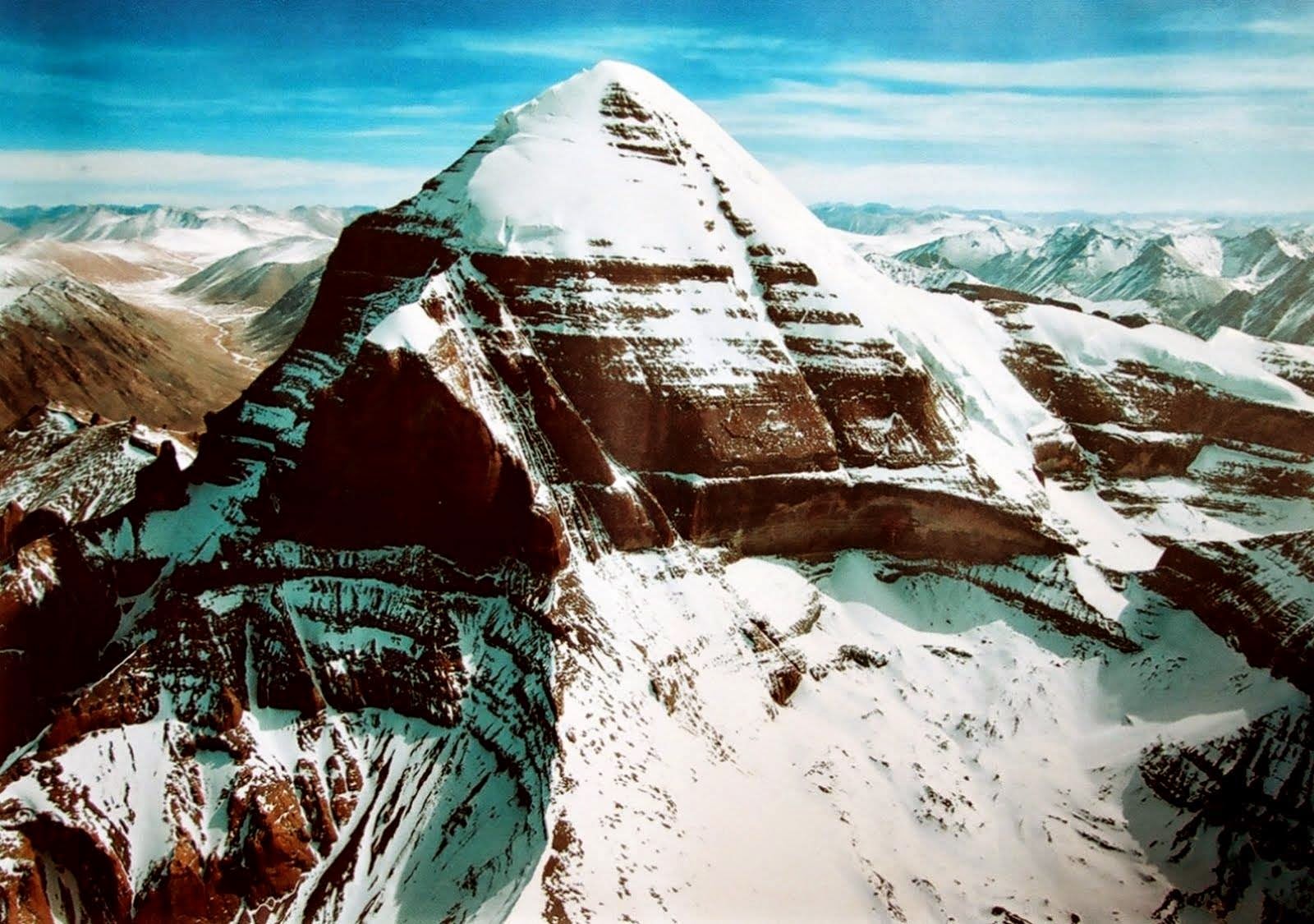
High Peaks Pure Earth has translated a blogpost by Woeser written in June 2014 for the Mandarin service of Radio Free Asia and published on her blog on June 8, 2014.
Woeser writes about the restrictions on Tibetans who wish to go to Mount Kailash on pilgrimage and make circumambulations. Mount Kailash is located in far western Tibet, in a sensitive border area close to Nepal and India.
Woeser has previously written about Mount Kailash and also about elderly Tibetans who travelled to India to attend Buddhist teachings in the past but were detained on their way back to Tibet.
“Local authorities Limit the Issuing of ‘Border Permits’, Prohibit Tibetans to go on Pilgrimage to the Sacred Mountain”
By Woeser
 There exists an extraordinary mountain, it is considered sacred land by traditional Tibetan Buddhism, Hinduism, the Bon religion and by Jainism; all these religions believe this mountain to be the centre of the world. It is called Gang Rinpoche in Tibetan, Mount Kailash in Sanskrit, and all Buddhists praise it as “the spiritual centre”. It is situated in Tibet, in what was traditionally referred to as “the three circles of Ngari”, it is the main peak of the Transhimalayan mountain range. It towers 6656 metres above sea level and is the most important of all sacred mountains in Tibet.
There exists an extraordinary mountain, it is considered sacred land by traditional Tibetan Buddhism, Hinduism, the Bon religion and by Jainism; all these religions believe this mountain to be the centre of the world. It is called Gang Rinpoche in Tibetan, Mount Kailash in Sanskrit, and all Buddhists praise it as “the spiritual centre”. It is situated in Tibet, in what was traditionally referred to as “the three circles of Ngari”, it is the main peak of the Transhimalayan mountain range. It towers 6656 metres above sea level and is the most important of all sacred mountains in Tibet.
Making a pilgrimage to the sacred mountain involves circumambulating it. According to Buddhist tantra, Mount Kailash’s prayer path naturally formed into a mandara and the path that pilgrims take resembles the ceremony of offering mandara. According to Hindu beliefs, circumambulating the mountain symbolises the protection of wild datura stramonium. Further, Buddhists believe that Mount Kailash and Siddhartha Gautama were both born in the year of the horse, making this the year the year to go on pilgrimage to the holy mountain.
This year is the year of the horse according to the Tibetan calendar. Hence, countless religious people have the strong wish to make a pilgrimage to Mount Kailash. Traditionally, the best time to do so would be in the 4th month of the Tibetan calendar, namely during “Saga Dawa”. On the 15th day of the 4th month a grand flag-raising ceremony is held at the foot of the mountain, at the spot marking the beginning and end point of the route circumambulating the mountain.
However, in order to go to Ngari Prefecture, Tibetans, including those living in the mountain area, must obtain an official border pass. This can be extremely difficult; in fact, it has become more and more difficult every year. Last year, a rumour spread that local authorities were not allowing Tibetans to go to the mountain altogether. They could not believe this. But at the beginning of 2014, Lhasa’s work units went from meeting to meeting to remind people not to go and circumambulate Mount Kailash and to not let any family members go either. Those who do not follow, would be penalised. Later on, another strict regulation emerged, stipulating that no one was allowed to take any annual leave before September 2014, otherwise they would run the risk of being fired. No Tibetans, whether monks or laity, were allowed to leave their home ground during “Saga Dawa” (May 5 – June 27).

At the end of April, a netizen who had travelled to Tibet forwarded what he claimed to be a notice issued by the Tibet border management office on Weibo: “Starting from April 24, 2014, the TAR will issue no permits for Ngari, for applications please go to the reception of your local security bureau.” The netizen commented: “This basically means that it is impossible to obtain a permit for Ngari in Lhasa”. This also means that any Tibetans in Lhasa who are not able to get permission to go to Ngari will not be able to circumambulate Mount Kailash.
A Tibetan netizen said: “If you live in the Tibetan areas of Sichuan, there is almost no chance of getting a border pass at all.” A Chinese traveller who managed to go to Ngari revealed: “Any non-locals or Tibetans are unable to go to Ngari! We were really lucky…” “Even after calling on his good relations and contacts, a Tibetan was in the end still refused a permit, apparently because a document stipulates that no Tibetans are allowed a border permit. This also means that apart from the few Tibetans who live in the area, no one else can go to legally visit the mountain…” even “Tibetan tour guides are not allowed in!”

A Tibetan online friend who is involved in Tibet tourism told me on Weibo how to obtain a frontier pass: “You have to send your ID card back to the place where you are registered; if your registration is in Tibet, there is nothing you can do.” “They are quite strict this year, the best is to get the pass in China a long time in advance.” A Chinese tourist celebrated: “We cannot get the pass anywhere here, but luckily I got one in Guangzhou”. Another traveller revealed: “I expect them to keep up the strict controls until the end of August.” “Or perhaps for the rest of the year.”

Of course, the reason for restricting the issuing of frontier passes for Ngari is a direct reaction to the Tibetan year of the horse, the traditional time for Tibetans to pilgrimage to Mount Kailash. However, a Tibetan netizen wrote: “this is not simply about limiting people to go to the holy mountain, it is actually about preventing people to attend the Kalachakra Initiations by the Dalai Lama in Ladakh, from July 3-14.” Indeed, His Holiness arrived in Ladakh, which directly borders Ngari, on July 1 to hold the 33rd Kalachakra Initiations. Last time, two years ago, it was held in the sacred land of Bodhgaya; back then thousands of Tibetans from inside Tibet went there to participate. Upon their return, they experienced a rude awakening. Many were forced into concentration-camp-like “education groups” where they suffered mental torment and their passports were confiscated.
At the end of April this year, an anonymous photographer took some pictures at the foot of Mount Kailash, showing large numbers of military vehicles, police cars and massive congregations of various special police and military personnel, just like the traveller noted: “On the path circumambulating the mountain, I saw countless soldiers and many checkpoints.” Most recently, the news spread that the mountain had already become a key site requiring the “maintenance of stability”.
This also meant that Tibetans living outside Tibet who already have a hard time returning home had no hope of circumambulating the holy mountain. A Tibetan staff member at the United Front Work Department reminded all Tibetans living outside China: “This year when you apply for a visa to return home, simply write ‘visiting relatives’ as your reason, do not write that you want to go to the mountain; this is because embassies of the PRC are not authorised to issue the needed border pass, so it might result in the rejection of your visa. The TAR has already stopped issuing border passes to locals; fellow Tibetans, if you want to go, you have to apply to the higher authorities, but whether you can actually obtain a pass is difficult to say.”

I know an exiled Tibetan living in Switzerland. He is already 60 years old and not in good health, but he once made a promise to himself to go and circumambulate Mount Kailash three times in his life. So he really hoped to be able to go on June 13 (the 15th day of the 4th month according to the Tibetan calendar) this year. Even if his life was at stake, going to the holy mountain was the biggest relief for him. His whole family had already prepared to assist him in realising his deepest dream; but can his wish be fulfilled?
I remember in 2002, I myself set out to circumambulate Mount Kailash; it took me almost 20 hours to complete the over 50 km long trail. Witnessing this extraordinary and wonderful mountain shape was like seeing an embodiment of the Buddhist symbol Mandala. I wrote on Weibo: “I am full of grief. 12 years ago, when I was on the path circling around the holy mountain I made a wish: In 12 years I will circumambulate the mountain again. But now it seems that my wish can hardly come true. Sad indeed.”



At the end of April this year, an anonymous photographer took these pictures at the foot of Mount Kailash, showing large numbers of military vehicles, police cars and massive congregations of various special police and military personnel.
June 2014






Pingback: “Our Sacred Land, Their Rubbish Dump (Part 1): About Chinese Artist Zhang Huan’s ‘Land Art’ Installation on Mount Kailash” By Woeser – High Peaks Pure Earth
Pingback: “Our Sacred Land, Their Rubbish Dump (Part 1): Chinese Artist Zhang Huan’s ‘Land Art’ Installation on Mount Kailash” By Woeser – High Peaks Pure Earth